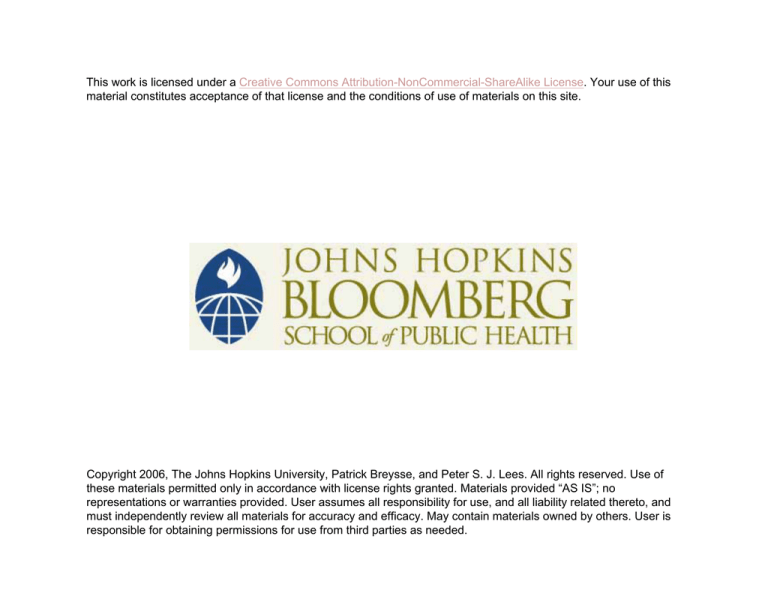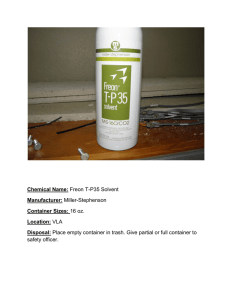
This work is licensed under a Creative Commons Attribution-NonCommercial-ShareAlike License. Your use of this
material constitutes acceptance of that license and the conditions of use of materials on this site.
Copyright 2006, The Johns Hopkins University, Patrick Breysse, and Peter S. J. Lees. All rights reserved. Use of
these materials permitted only in accordance with license rights granted. Materials provided “AS IS”; no
representations or warranties provided. User assumes all responsibility for use, and all liability related thereto, and
must independently review all materials for accuracy and efficacy. May contain materials owned by others. User is
responsible for obtaining permissions for use from third parties as needed.
Standards and Guidelines
and Ethical Code of Conduct
Patrick N. Breysse, PhD, CIH
Peter S.J. Lees, PhD, CIH
Johns Hopkins University
Section A
Historical Perspective
Hatch Curve
Hatch, T: Changing Objectives in
Occupational Health. Industrial Hygiene
Journal 3(1):1–7 (1962)
Implications:
– Man-environment interaction is
complex
– Shift in emphasis from overt illness
to physiological disturbances that
may be precursors of disease
4
Section B
ACGIH Threshold Limit Values
and Biological Exposure Indices
Threshold Limit Value (TLV)
Threshold limit values (TLVs) refer to
airborne concentrations of substances
and represent conditions under which it
is believed that nearly all workers may
be repeatedly exposed day after day
without adverse health effects
Continued
6
Threshold Limit Value (TLV)
Because of wide variation in individual
susceptibility, however, a small
percentage of workers may experience
discomfort from some substances at
concentrations at or below the TLV
A smaller percentage may be affected
more seriously by aggravation of a preexisting condition or by development of
an occupational illness
Continued
7
Threshold Limit Value (TLV)
Published by ACGIH
Established in 1946 (updated annually)
Approximately 750 chemicals covered
Guidelines not law
Documentation of TLVs and BEIs
Method of adoption
“Balancing of health considerations and
cost to industry” –ACGIH 1948
8
Examples of TLVs
Adopted Values
Substance
(CAS No.)
TWA
(ppm/mg/m³)
STEL/C
(ppm/mg/m³)
Notations
Mol Wgt
TLV Basis –
Critical Effect(s)
Azinphos-methyl (86-50-0)
0.2 mg/m³
__
Skin; A4; BEI
317.34
Cholinergic
Barium (7440-39-3)
and soluble compounds, as Ba
0.5 mg/mg³
__
A4
137.30
Irritation; GI; burns;
muscle toxin
10 mg/m³ (E)
__
__
233.43
Pneumoconiosis (baritosis)
10 mg/m³
__
A4
290.32
Dermatitis; irritation
__
__
A2
228.30
Cancer
Benzene (71-43-2)
0.5 ppm
2.5 ppm
Skin; A1; BEI
78.11
Cancer
Benzidine (92-87-5)
__
__
Skin; A1
184.23
Cancer (bladder)
Benzo[b]fluoranthene (205-99-2)
__
__
A2
252.30
Cancer
Benzo[a]pyrene (50-32-8)
__
__
A2
252.30
Cancer
Benzotrichloride (98-07-7)
__
C 0.1 ppm
Skin; A2
195.50
Irritation; cancer
Benzoyl chloride (98-88-4)
__
C 0.5 ppm
A4
140.57
Irritation
Benzoyl perozide (94-36-0)
5 mg/m³
__
A4
242.22
Irritation
Benzyl acetate (140-11-4)
10 ppm
__
A4
150.18
Irritation
Benzyl chloride (100-44-7)
1 ppm
__
A3
126.58
Irritation; lung
Barium sulfate (7727-43-7)
Benomyl (17804-35-2)
Benz[a]anthracene (56-55-3)
P-Benzoquinone, see Quinone
Source: Adapted from TLV book
9
Typical Time Constants
Time-weighted average (TWA)
– Contaminant concentration
averaged over a period of time;
usually over a full work shift–i.e.,
eight-hour TWA
Continued
10
Typical Time Constants
Short-term exposure limit (STEL)
– Contaminant concentration
averaged over a 15-minute period
Continued
11
Typical Time Constants
Ceiling
– Instantaneous concentration; or
concentration averaged over a 15
minute period if technology does not
exist to measure instantaneous
concentrations
12
Skin Notation
Skin notation (S) indicates substances
for which there is the potential for
substantial contribution to exposure via
adsorption through the skin
– Examples:
• Diazanon
• Chlordane
• Carbon disulfide
• Benzene
13
Sensitizer Notation
Listed substances followed by the
sensitizer notation (SEN) refer to the
confirmed potential for worker
sensitization as a result of dermal
contact and/or inhalation exposure
– Examples
• Formaldehyde
• Flour dust
• Glutaraldehyde
14
Carcinogenicity Classification
A1: Confirmed human carcinogen
A2: Suspected human carcinogen
A3: Confirmed animal carcinogen with
unknown relevance to humans
A4: Not classifiable as a human
carcinogen
A5: Not suspected as a human
carcinogen
15
Excursions
Excursions are concentrations above
the TLV and are permitted as long as
they are balanced by concentrations
below the TLV such that the eight-hour
TWA is less than the TLV
Refer to the magnitude of these
elevated concentrations and current
guidance is that up to 30 minutes at
three times the TLV is permitted but five
times the TLV is not permitted
16
Biological Exposure Indices (BEIs)
Measurement of chemical determinant
in a biological media
Examples
– Acetone in urine
– S-Phenylmercapturic acid
(metabolite of benzene) in urine
– n-Hexane in end-exhaled air
– Lead in blood
17
Section C
Occupational Safety and Health
Administration (OSHA) Standards
Permissible Exposure Limits
(PEL)
Set by OSHA
Established in 1970 (rarely updated)
Antecedents–Walsh Healey, TLV, ANSI
Approximately 450 chemicals covered
Eight-hour TWA, STEL, and C
Z table and complete standards
Legally enforceable
Method of promulgation
19
OSHAct
Each employer
“Shall furnish to each of his employees
employment and a place of
employment which are free from
recognized hazards that are causing or
are likely to cause death or serious
physical harm to his employees;
Shall comply with occupational safety
and health standards promulgated
under this Act.”
20
Criteria for PEL
from OSHAct
“The Secretary, in promulgating
standards dealing with toxic materials
or harmful physical agents under this
subsection, shall set the standard which
most adequately assures, to the extent
feasible, on the basis of the best
available evidence,…
Continued
21
Criteria for PEL
from OSHAct
… that no employee will suffer material
impairment of health or functional
capacity even if such employee has
regular exposure to the hazard dealt
with by such standard for the period of
his working life”
22
Examples of PELs
Source: US Code of Federal Regulations
23
OSHA Standards
29 CFR
Part 1910: Occupational Safety and
Health Standards
Part 1915: Occupational Safety and
Health Standards for Shipyard
Employment
Part 1926: Safety and Health
Regulations for Construction
Part 1928: Occupational Safety and
Health Standards for Agriculture
24
OSHA Standards
29 CFR Part 1910
Subpart Z Authority for 1910 subpart Z
1910.1000 Air Contaminants
1910.1000 Table Z-1 Limits for Air
Contaminants
1910.1000 Table Z-2
1910.1000 Table Z-3 Mineral Dusts
25
29 CFR Part 1910
Complete Standards
Examples
1910.1001 Asbestos
1910.1002 Coal tar pitch volatiles
1910.1017 Vinyl Chloride
1910.1018 Inorganic Arsenic
1910.1025 Lead
1910.1028 Benzene
1910.1051 1,3-Butadiene
26
OSHA Standards
Benzene 1910.1028
Scope and
application
Definitions
PELs
Regulated areas
Exposure
monitoring
Methods of
compliance
Respiratory
protection
Protective clothing
and equipment
Med. surveillance
Hazard
communication
Record-keeping
27
OSHA Terms
Permissible exposure limit (PEL) is that
concentration expressed as an eighthour time-weighted average, which
shall not be exceeded
Short term exposure limit (STEL) is that
concentration expressed as a 15minute time-weighted average, which
shall not be exceeded
Continued
28
OSHA Terms
Ceiling (C) is that concentration which
shall never be exceeded, although it is
expressed as a 10- or 15-minute TWA
Action level (AL) is defined as one-half
the PEL
– Concentrations in excess of the AL
trigger specified activities in
complete standards
Continued
29
OSHA Terms
Immediately dangerous to life and
health (IDHL) signifies concentrations
to substances for which exposure of
more than 30 minutes would be
expected to be fatal
– Used in the selection of respirators
Continued
30
OSHA Terms
OSHA does not classify carcinogens,
but instead relies on the classifications
made by the National Toxicology
Program (NTP) and the International
Agency for Research on Cancer (IARC)
31
Section D
National Institute for Occupational
Health and Safety (NIOSH)
and Other Organizations
NIOSH
National Institute for Occupational
Safety and Health (NIOSH)
– Part of Centers for Disease Control
– Research, recommendation, and
training duties
– Recommended Exposure limits
(RELs)
33
Recommended Exposure
Limits (RELs)
Recommended by NIOSH
Created by the OSHAct
Associated with Criteria Documents
Recommendations to OSHA
Used as another guideline but not law
Based solely on health considerations
Usually below corresponding PEL
34
Other Relevant Organizations
American National Standards Institute
(ANSI)
International Radiation Protection
Association (IRPA)
American Society of Heating,
Refrigeration, and Air Conditioning
Engineers (ASHRAE)
Institute for Electrical and Electronics
Engineers (IEEE)
35
Section E
Code of Ethics
Cannons of Ethical Conduct
1. Practice their profession following
recognized scientific principles with
the realization that the lives, health,
and well-being of people may depend
upon their professional judgment and
that they are obligated to protect the
health and well-being of people
Continued
37
Cannons of Ethical Conduct
2. Counsel affected parties factually
regarding potential health risks and
precautions necessary to avoid
adverse health effects
Continued
38
Cannons of Ethical Conduct
3. Keep confidential personal and
business information obtained during
the exercise of industrial hygiene
activities, except when required by law
or overriding health and safety
considerations
Continued
39
Cannons of Ethical Conduct
4. Avoid circumstances where a
compromise of professional judgment
or conflict of interest may arise
5. Perform services only in the areas of
their competence
6. Act responsibly to uphold the integrity
of the profession
40








